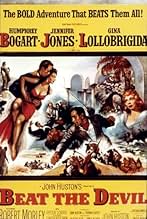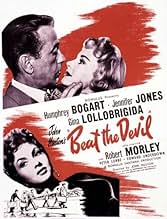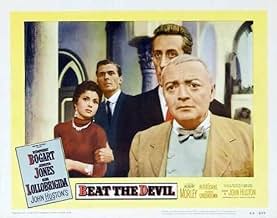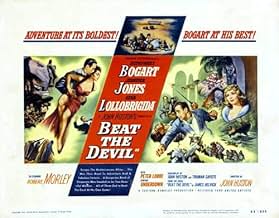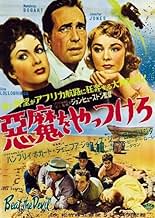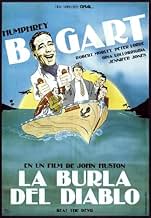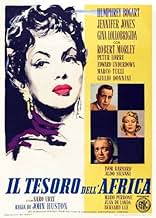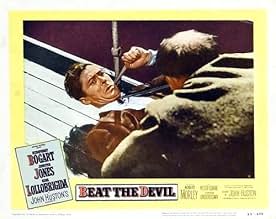Auf dem Weg nach Afrika ist neben einer Gruppe von zwielichtigen Gestalten, die sich dort Reichtum erhoffen, auch ein scheinbar unschuldiges britisches Paar. Sie begegnen sich und das Abente... Alles lesenAuf dem Weg nach Afrika ist neben einer Gruppe von zwielichtigen Gestalten, die sich dort Reichtum erhoffen, auch ein scheinbar unschuldiges britisches Paar. Sie begegnen sich und das Abenteuer nimmt seinen Lauf ...Auf dem Weg nach Afrika ist neben einer Gruppe von zwielichtigen Gestalten, die sich dort Reichtum erhoffen, auch ein scheinbar unschuldiges britisches Paar. Sie begegnen sich und das Abenteuer nimmt seinen Lauf ...
- Auszeichnungen
- 1 wins total
- Captain of SS Nyanga
- (as Saro Urzi)
- Hotel Manager
- (Nicht genannt)
- Barman
- (Nicht genannt)
Empfohlene Bewertungen
A riotous, imperfect, silly, brazen, forward thinking, throwaway, brilliant spoof.
For starters, you know something will happen with Huston directing Bogart. And throw in an aging bulging Peter Lorre as a German named O'Hara. O'Hara comes into a room and says to Bogart, playing a disaffected American, "Why do you always make jokes about my name, huh? In Chile the name of O'Hara is, is a tip top name. Many Germans in Chile have become to be called O'Hara."
And so there is a dig at a lot of stereotypes, most of them with shades of truth. The style of the film is not film noir, as many people say, but more just an intrigue or war time spy film. The most direct connection seems to be Huston's own Maltese Falcon, but even this is based on Bogart and Lorre appearing in both films (as well as a fun appearance in Beat the Devil by Robert Morely doing a kind of less pleasant Sidney Greenstreet).
I sensed a lot of direct influence from Lady from Shanghai, an overlooked and frankly brilliant and daring Orson Welles film from a few years earlier. Check out the slightly surreal plot, the strange sequences of locations (land, boat, land, with an exotic overture in the middle), and the characters themselves, including Jennifer Jones as a kind of decorative female not unlike Rita Hayworth in Shanghai. There is even a man-to-man discussion of Heyworth in Beat the Devil between Bogart and a unlikely Muslim captor in a generally hilarious scene.
The film is flawed by its own excesses at times, and by a kind of frivolousness that Welles, for one, avoided by making his film's excesses more formal and less literary. Huston, like Bogart, was literate by nature, as a lot of heavy drinking men were in those days, and the dialog, as brilliant as it is (and shepherded along by Huston and Truman Capote in tandem), isn't always in synch with the acting, and with the flow of events. So if we don't really expect anything from the plot, per se, knowing it's all just in fun, we come to expect more from the series of remarks, the twists of fate, and the yawning expectations of an audience used to very high quality writing and acting by 1953.
I know some people who just can't finish watching this because it strikes them as phony and childish. Bogart might agree--he lost money on the production. But there are some great moments, and an ongoing repartee that works well, or works superbly, at different moments. I'd cash out a couple of actors for others more idiosyncratic, I think. But no one asked me, I know. Watch it for what it is. And check out Lady from Shanghai and see if you see what I mean.
The cast is absolutely top notch. Bogart is perfect as Billy Dannreuther, a man who has a friend that will line him and his associates up with some land in Africa that is rich with uranium. It's always nice to see Bogie prove that he had a great sense of humor, and didn't mind poking fun at himself. Jennifer Jones, who, for some reason, always reminded me of Vivien Leigh (in "Streetcar")in this picture is terrific as Mrs. Chelm. But it is Robert Morley who steals the picture for me. Sometimes menacing, sometimes charming, he is a delight to watch.
Huston and Capote have done a great job of blending the different genres without letting them get all caught up in each other. I do wish that the final scene was written a little better, but the movie is still a lot of fun.
Caution - because the film was allowed to enter the public domain, there are a lot of really lousy prints out on the market, even on DVD. If you want this film for your own collection, do yourself a favor and spend a couple of extra dollars and buy a good print.
7 out of 10
Although Bogart does not look his best (this film was made toward the end of his life), he offers an understated yet very witty performance as Billy Dannreuther, the man the crooks hire to make the land purchase. His leading ladies, bombshell Gina Lollobrigida and an unexpectedly blonde Jennifer Jones, are equally effective in the roles of Bogart's cheerfully pragmatic wife and the pathological liar with whom Bogart becomes romantically entangled. But the big news in this film is the supporting cast. Robert Morley, Peter Lorre, Ivor Barnard, and Marco Tulli give drop-dead-funny performances as the largely incompetent foursome behind the landsnatch scheme; Edward Underdown (as Jones' long suffering husband) is simply the most completely ludicrous Brit to hit the screen since 1930s screwball comedy; and all the cameo players nail their roles to perfection.
It would be unforgivable to give away too much of the story, but suffice to say that one wrong turn leads to another. The film never overplays its hand, maintaining a low key tone that sets off the wickedly funny script to delightful effect. Some viewers may not get the joke--much of BEAT THE DEVIL requires the ability to appreciate covert humor--but those who do will find the movie bears repeat viewing. Recommended.
Gary F. Taylor, aka GFT, Amazon Reviewer
It looks however as if Beat the Devil may have begun life as a serious thriller. All the business about criminals going after uranium mines in Africa seems fairly original, and is certainly not an archetypal noir plot. And really there is no grand satire here, and no lampooning of specific genre clichés. The story's premise is essentially serious, yet is written with comedy characters and comical mishaps along the way. It's if Huston and his co-writer Truman Capote simply gave up on following it through and instead decided to have a bit of fun with it.
Nevertheless, Huston shoots this one with the same thoughtfulness and precision as he would a drama. As always, he favours set-ups which keep multiple actors in shot together, background and foreground, minimising on cuts between them. With some neat movements he is able to bring the right person to our attention at the right moment, for example the scene in which we first see Humphrey Bogart and Gina Lollobrigida. Bogart paces back and forth in the foreground moving in and out of shot, while Lollobrigida is in mid-shot but sat in the same place, meaning the two of them take turns to be the focal point without lots of editing or obtrusive camera-work. Another neat touch is when the major approaches Bogart at the outdoor table, starting off in the background as if an extra, until it becomes apparent he is worth taking note of. Huston's technique is about elaborate arrangement to keep all characters involved and performances intact without the distractions of film form.
And here there are many characters and performances worth looking at. As befitting for the tone, this is a real outing for oddball supporting players. Peter Lorre is at his very best, all shiftiness and lethargic mannerisms, while Robert Morley gleefully portrays his blustering and conspicuous opposite, and Ivor Barnard hams up his caricature of the puffed-up ex-army fascist. It appears these three fine character actors have been told to simply let go and play their familiar types to the hilt. By contrast, lesser-known Italian Marco Tulli gives a far more restrained performance, but he is in a way the funniest. There's a great moment somewhere in there while the other three are bickering and he is just sat in the middle of the shot, quietly blinking away like some daft meerkat. Even the tiniest roles are filled – often impeccably – by comedy players, many of whom are not well-known in English-language cinema. There's also a great turn by Jennifer Jones, at her most comical and almost unrecognisable as an eccentric Englishwoman, showing superb comic timing as she casually beats her husband at chess. With so much scene-stealing going on, it's possible to forget this is ostensibly a Humphrey Bogart movie.
But while Beat the Devil is full of quirky characters and has numerous funny little moments, it doesn't have much point beside that. The humour is never exactly hilarious because the whole thing really doesn't seem conceived as a comedy. There's not enough of the interaction between crazy characters and sane world which drives wild comedy (such as the Marx Brothers), because in Beat the Devil virtually everyone and everything is crazy. Meanwhile the only completely straight characters (Bogart and Lollobrigida) are simply dull marginalised figures who exist separately from the comedy yet don't have the strength to perk up their end of the movie. Overall it is just a chaotic mess that happens to be worth a chuckle here and there.
Beat The Devil (directed by John Huston, who co-wrote the script with the up-and-coming Truman Capote) improvises a loose, comic riff on the international adventure genre. Thankfully, it's not unhinged or absurd enough to be a dreaded `spoof,' and emphatically not one (as it's become a commonplace to assume) of the noir cycle. In narrative, point of view and look (there's no coherent visual style), Beat The Devil bears not the slightest resemblance to film noir, which, by this point, was slyly starting to parody itself anyway.
The plot's McGuffin concerns uranium deposits in central Africa, which draw a disreputable and multinational crew of opportunists who hope to strike it rich by sticking it to their various motherlands. The joke lies in that these bumblers keep getting taken in by one another's cover stories, pretensions and lies and falling for one another's spouses. It's not a bad joke, but it needs a bit more rigor to flesh it out from a skit to a feature film.
Of course it's funny, if haphazardly. A blonde Jennifer Jones, juggling an English accent as if with a mouth full of prunes, comes straight out of screwball comedy (who knew?), and Gina Lollobrigida (when not waylaid by her own attempts at English) occasionally matches her. Peter Lorre, looking much like the short and rotund Capote of the future, again displays his instinctive flair for subversive comedy (his past in sinister parts limited what might have been a long and enjoyable career). And Robert Morley, crisp as a toasted if unusually thick crumpet, serves up every line like a butler bearing a decanter of vintage port. Bogart, on the other hand, can't persuasively hide his age and infirmity, and his role as debonair lover and man of action demands superhuman suspension of disbelief (maybe he was just thinking of all the money he was going to lose).
Yet having fun doesn't have to mean that plot is irrelevant, some boring old rule made to be broken. Part of the movie's folklore is that Capote stayed up all night writing the next day's pages; maybe so, but didn't he or Huston know where they were going? Once the characters wade up on the North African shore to be apprehended by `Arabs' (surely, Bedouins?), there's no more pretense of a cohesive script or a halfway satisfying storyline. Finding a plausible way out of all the intrigue, however tongue-in-cheek it might have been, wouldn't have killed the laughs, now, would it?
Wusstest du schon
- WissenswertesHumphrey Bogart was involved in a serious automobile accident during production of this film, which knocked out several of his teeth and hindered his ability to speak. John Huston reportedly hired a young British actor noted for his mimicry skills to rerecord some of Bogart's spoken lines during post-production looping. Although it is undetectable when viewing the film today, it is Peter Sellers who provides Bogart's voice during some of the scenes in this movie. However this cannot be confirmed.
- PatzerBogie enters the lifeboat wearing a plain suit but gets out wearing a pinstriped suit.
- Zitate
Julius O'Hara: Time. Time. What is time? Swiss manufacture it. French hoard it. Italians squander it. Americans say it is money. Hindus say it does not exist. Do you know what I say? I say time is a crook.
- Alternative VersionenThe original American release version was truncated and had scenes moved around, making a mess of the story line. The uncut version--released overseas by Romulus--was finally restored in the U.S. by Sony in 2016.
- VerbindungenEdited into Your Afternoon Movie: Beat the Devil (2022)
Top-Auswahl
- How long is Beat the Devil?Powered by Alexa
Details
- Erscheinungsdatum
- Herkunftsländer
- Sprachen
- Auch bekannt als
- Beat the Devil
- Drehorte
- Produktionsfirmen
- Weitere beteiligte Unternehmen bei IMDbPro anzeigen
Box Office
- Budget
- 1.000.000 $ (geschätzt)
- Laufzeit1 Stunde 29 Minuten
- Farbe
- Seitenverhältnis
- 1.37 : 1
Zu dieser Seite beitragen



